Special Report
Companies Paying Americans the Least
Published:
Last Updated:

Some of the biggest companies in the country pay their workers relatively little. Low-wage jobs in these companies are almost always hourly, low-skilled positions.
The typical U.S. worker earns $17.81 an hour. In a number of service industries, the median pay is far lower. Gasoline stations and restaurants pay the lowest median wages, with the typical worker earning less than $10 an hour. In bookstores and newsstands, used merchandise stores, department stores, shoe stores, clothing stores, beer, wine, and liquor stores, and grocery stores, the typical worker earns less than $11 an hour.
Most large corporations do not publish the average wage they pay their workers. Based on the methodology used by the National Employment Law Project, an employment advocacy organization, in its 2012 report “Big Business, Corporate Profits, and the Minimum Wage,” 24/7 Wall St. identified the 25 large companies that pay employees the lowest wages.
Click here to see the full list of companies paying Americans the least.
Click here to see our detailed findings and methodology.

25. Chipotle Mexican Grill, Inc.
> Workforce: 64,570
> Annual profit: $22.9M
> CEO salary: $1.7M (Steve Ells)
> Industry: Eating places
Chipotle crew members earn less than $10 an hour on average, according to employee reviews on job review site Glassdoor. Chipotle ranks 25th among the companies paying Americans the least because of the size of its 64,570 person workforce in an industry that pays relatively low wages. As is the case with many companies on this list, none of Chipotle’s employees are covered by collective bargaining agreements, which is a common way for workers to negotiate higher wages.
Chipotle has faced numerous setbacks in recent years, with e-coli, salmonella, and norovirus outbreaks in multiple locations on multiple occasions and as recently as this past summer at a Virginia restaurant. Partially as a result, the company’s revenue fell by 13.3% from 2015 to 2016.
[in-text-ad]

24. Cracker Barrel Old Country Store, Inc. (Nasdaq:CBRL)
> Workforce: 73,000
> Annual profit: $201.9M
> CEO salary: $2.8M (Sandra B. Cochran)
> Industry: Eating places
Restaurants pay notoriously low wages. The typical restaurant worker earns just $9.80 an hour, far less than the national median hourly wage of $17.81. Before tips, an estimated 14.9% of employees in food preparation and serving-related occupations are paid either minimum wage or less, by far the largest share of any industry. With a workforce of approximately 73,000, Cracker Barrel is one of the largest restaurant chains in the country and is a major contributor to the low wages across the industry. The Cracker Barrel political action committee spent $490,000 from 2011 to 2015 on federal lobbying activities mostly aimed at freezing the federal tipped minimum wage at $2.13 an hour. Cracker Barrel has also faced lawsuits claiming the company unlawfully withheld overtime pay from various mid-level employees.

23. Nordstrom, Inc. (NYSE:JWN)
> Workforce: 78,000
> Annual profit: $354.0M
> CEO salary: $2.0M (Blake W. Nordstrom)
> Industry: Family clothing stores
The typical clothing store employee earns just $10.63 an hour, far less than the national median hourly wage of $17.81. Nordstrom employs approximately 78,000 employees, among the most of any major clothing chain. On job review site Glassdoor, Nordstrom employees regularly complain about low, commission-based pay and long hours. The company also has a history of anti-worker federal lobbying. Nordstrom is one of two dozen major U.S. corporations that provided financial support to the Association for Responsible Alternatives to Worker’s Compensation, a lobbying group that helped write legislation that limits injured workers’ access to lost wages and medical care.

22. Ross Stores, Inc. (Nasdaq:ROST)
> Workforce: 78,600
> Annual profit: $1.1B
> CEO salary: $4.4M (Barbara Rentler)
> Industry: Family clothing stores
Discount department store chain Ross Stores employs 78,600 people in both full- and part-time positions in 1,533 locations nationwide. Sales associates, the most common position within the company, earn an average wage of only about $8.57 an hour, far less than the national median hourly wage of $17.81.
While most U.S. department stores have reported yearly revenue declines, Ross Stores is an exception. The company’s fiscal 2017 net sales of $12.9 billion mark a three-year high and a 7.8% increase from the previous year. So while many department stores are shuttering dozens of locations a year, Ross Stores added net 87 new locations between the beginning of 2016 through the beginning of 2017.
[in-text-ad-2]

21. Genesis Healthcare, Inc. (NYSE:GEN)
> Workforce: 82,000
> Annual profit: -$118.1M
> CEO salary: N/A (George V. Hager)
> Industry: Skilled nursing care facilities
Genesis Healthcare is a holding company, which, through its subsidiaries, operates some 450 nursing facilities and senior living communities and 1,700 rehabilitation therapy locations across the United States. While many positions at the company are high paying, including those of physical therapists, speech language pathologists, and practical nurses, many other jobs are far lower skilled and lower paid.
Labor unions are a relatively common way for workers to increase their bargaining power and ultimately earn higher salaries. However, only about 11% of Genesis Healthcare’s total labor force is represented by unions.
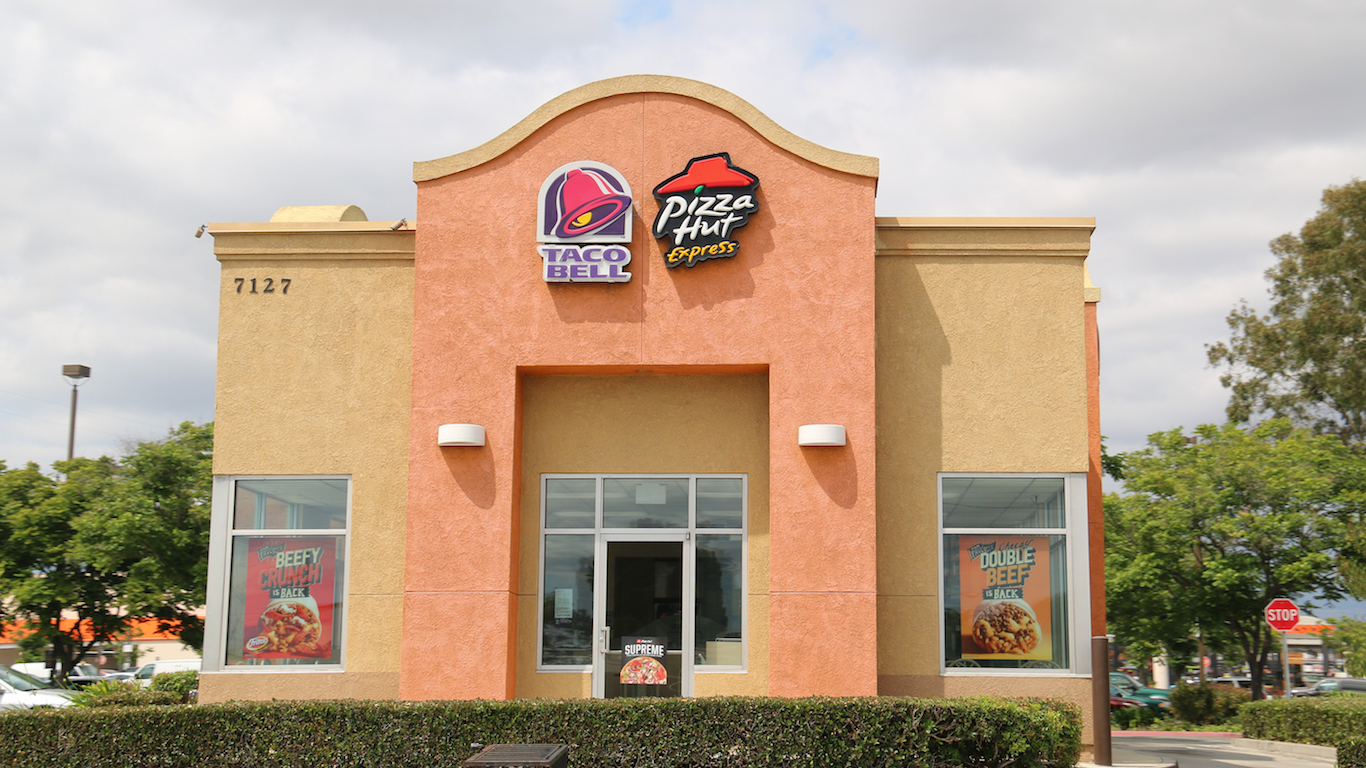
20. Yum! Brands, Inc. (NYSE:YUM)
> Workforce: 90,000
> Annual profit: $1.6B
> CEO salary: $5.3M (Greg Creed)
> Industry: Eating places
Yum! Brands is a global restaurant company that owns the KFC, Pizza Hut, and Taco Bell restaurant chains. Most of the company’s roughly 90,000 employees are paid on an hourly basis. Average wages at common positions at the company’s restaurants rarely exceed $10 an hour and go as low as $7.55 for Pizza Hut delivery drivers. To compare, the national median hourly wage is $17.81.
Though three major restaurants fall under the Yum! Brands umbrella, they are each managed by their own CEO, and partially as a result, employees report different levels of satisfaction. KFC employees appear the least satisfied, as less than half of those surveyed on Glassdoor would recommend a job with the company to a friend, and only 58% approve of CEO Muktesh Pant, one of the lower CEO approval ratings of any Fortune 500 company.
[in-text-ad]

19. Bloomin’ Brands, Inc. (Nasdaq:BLMN)
> Workforce: 97,000
> Annual profit: $46.3M
> CEO salary: $1.0M (Elizabeth A. Smith)
> Industry: Eating places
One of several restaurant companies to make this list, Bloomin’ Brands is the company behind several popular restaurant chains, including Outback Steakhouse, Bonefish Grill, and Carrabba’s Italian Grill. Much of the labor force working in the restaurant industry relies on tips because wages are so low. At Outback Steakhouse, the average hourly wage for a hostess is only $5.90 and servers earn only $4.16 an hour. Average wages are not much different at the company’s other restaurant chains.
As is the case with nearly company on this list, Bloomin’ Brands CEO Elizabeth A. Smith is well compensated. In 2016, Smith earned a base salary of $1.0 million and additional $4.5 million in stock options and other bonuses.

18. Kindred Healthcare, Inc. (NYSE:KND)
> Workforce: 100,100
> Annual profit: -$610.6M
> CEO salary: $2.4M (Benjamin A. Breier)
> Industry: Skilled nursing care facilities
The typical worker at a continuing care retirement facility earns just $11.94 an hour, far less than the national hourly median wage of $17.81. With approximately 100,100 employees, Kindred Healthcare is nearly the largest company in the U.S. skilled nursing care facility industry. According to employee reviews posted on job review site Glassdoor, some of the drawbacks of working at Kindred Healthcare include poor pay, infrequent raises, and the lack of a 401(k) matching program. Kindred has also faced several lawsuits related to employee compensation. According to national policy resource center Good Jobs First, since 2000, Kindred Healthcare has been the subject of 15 lawsuits related to wage violations and has paid $3.3 million in settlements.

17. J. C. Penney Company, Inc. (NYSE:JCP)
> Workforce: 106,000
> Annual profit: $1.0M
> CEO salary: $2.4M (Marvin R. Ellison)
> Industry: Department stores
Collectively, major American department stores employ hundreds of thousands of people and pay them relatively little. J.C. Penney is among them. The company employs some 106,000 workers across over 1,000 locations nationwide. Sales associates, by far the most commonly reviewed position at the company on Glassdoor, earn an average wage of only $9.07 an hour — far less than the national median hourly wage of $17.81.
As is the case with many major department stores, J.C. Penney has been struggling for years and is facing the prospect of continued declining revenue in the coming years as online shopping continues to gain favor with American consumers. J.C. Penney’s net sales are down from $12.6 billion in fiscal 2016 to $12.5 billion in fiscal 2017.
[in-text-ad-2]

16. Dollar General Corporation (NYSE:DG)
> Workforce: 121,000
> Annual profit: $1.3B
> CEO salary: $2.1M (Todd J. Vasos)
> Industry: Variety stores
The Dollar General sells everyday products such as snacks, cleaning supplies, houseware, and beauty aids at steep discounts — as its name suggests. Selling at a discount often requires significant cost-cutting measures in order to remain profitable, and low employee wages and salaries are one way Dollar General appears to save. According to Dollar General employee reviews of the company on Glassdoor, sales associates earn only $8.81 per hour on average, far less than the national median hourly wage of $17.81.
There are some 12,500 Dollar General locations across 43 states that employ 121,000 Americans.
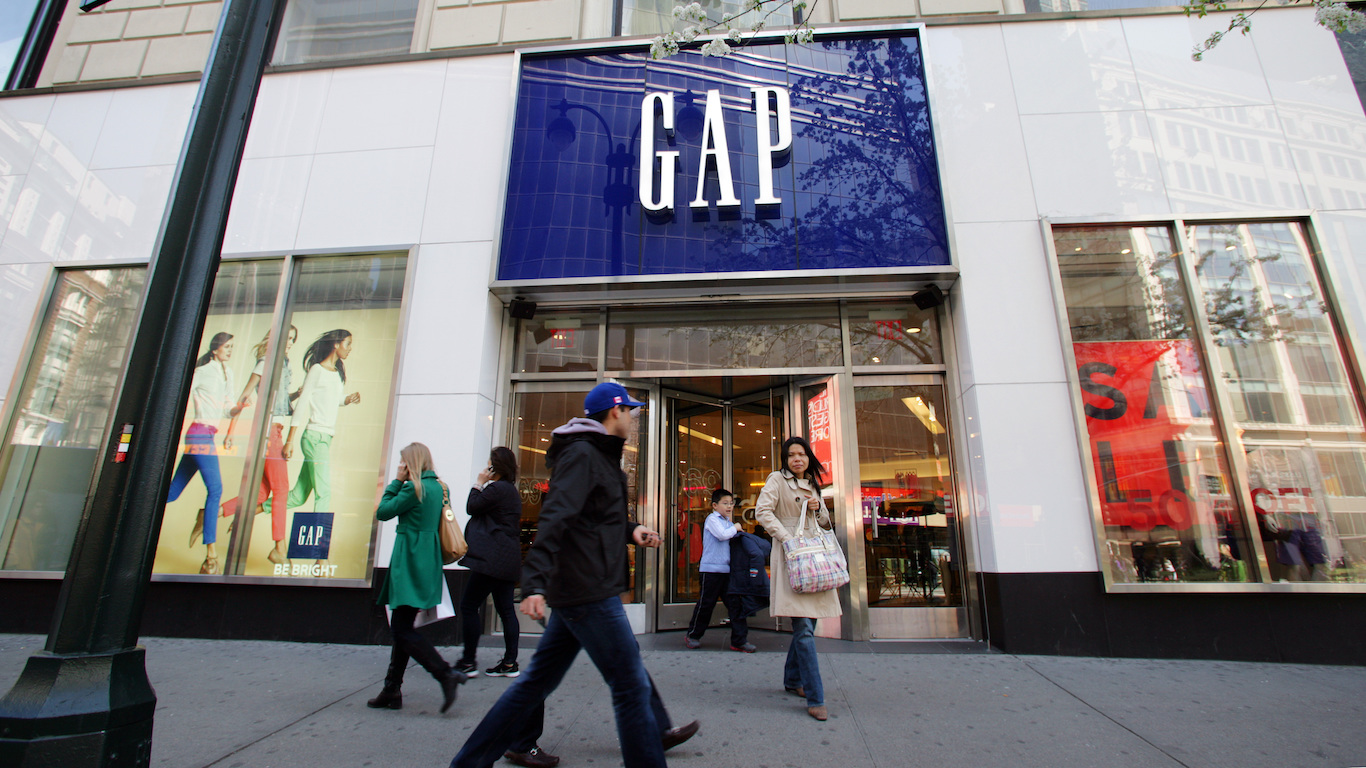
15. The Gap, Inc. (NYSE:GPS)
> Workforce: 135,000
> Annual profit: $676.0M
> CEO salary: $2.3M (Arthur Peck)
> Industry: Family clothing stores
Like many brick-and-mortar retailers, The Gap, Inc. is hurting as online shopping becomes increasingly popular. The company closed some 244 North American stores in 2015 and 2016, only opening 180 over the same period. With revenues declining in each of the last two years, the company reported net sales of only $15.5 billion in fiscal 2017, a three-year low. Partially as a result, not only are company workers not paid well, but many are also being laid off. Currently, The Gap, Inc. employs some 135,000 workers, the fewest in five years and down from 141,000 in 2015.
The Gap, Inc. owns a number of clothing retail brands, including Banana Republic, Old Navy, and Gap.
[in-text-ad]

14. Kohl’s Corporation (NYSE:KSS) > Workforce: 138,000
> Annual profit: $556.0M
> CEO salary: $2.4M (Kevin Mansell)
> Industry: Department stores
Department store chain Kohl’s Corporation employs about 32,000 workers full time and 106,000 part time. Sales floor associates, the most common type of job at Kohl’s department stores, earn little more than $8.71 an hour on average, far less than the national hourly median wage of $17.81. Furniture sales associates, the most common salaried job at the company, earn an average of only $20,871 per year, which is only a few hundred dollars above the poverty line for a family of three.
Kohl’s is one of many U.S. department stores forced to run leaner operations as online shopping becomes increasingly popular. The company’s revenue in fiscal 2017 was $18.7 billion, down from $19.2 billion the previous year.

13. Sears Holdings Corporation (Nasdaq:SHLD)
> Workforce: 140,000
> Annual profit: -$2.2B
> CEO salary: $1.0M (Edward Scott Lampert)
> Industry: Department stores
Sears Holdings Corporation is the parent company of both Sears and Kmart department stores. Sales associates at Sears department stores earn an average wage of only $8.54 an hour. Cashiers earn an even lower hourly wage of $8.37. To compare, the national median hourly wage is $17.81. Low wages do not likely help employee morale. Only 16% of Sears employees who have submitted reviews on Glassdoor approve of CEO Edward Lampert. Additionally, only about 1 in every 4 Sears employees reviewing the company on Glassdoor would recommend a job with the company to a friend. Morale and wages at the company’s Kmart department stores are not much better.
Low employee morale may currently be the least of the company’s problems. As e-commerce continues to gain favor with American consumers, traditional brick-and-mortar retailers like Sears are feeling the squeeze. So far this year the company has announced over 300 Sears and Kmart store closings.

12. Macy’s, Inc. (NYSE:M)
> Workforce: 148,300
> Annual profit: $611.0M
> CEO salary: N/A (Jeffrey Gennette)
> Industry: Department stores
Macy’s Inc. employs some 148,300 Americans across 829 Macy’s, Bloomingdale’s, and Bluemercury stores. The Macy’s department store is by far the company’s largest brand with some 673 locations nationwide. According to Macy’s employee reviews submitted on Glassdoor, Macy’s sales associates, by far the most commonly reviewed job at the company, earn an average of only $9.40 an hour, far less than the national median hourly wage of $17.81.
It is unlikely Macy’s employees will see significantly higher wages in the foreseeable future. The company’s once seemingly untouchable market share is now losing ground to e-commerce and companies like Amazon. The company’s revenue has fallen in each of the last two years, and the company closed a net of 39 Macy’s department stores in fiscal 2015.
[in-text-ad-2]
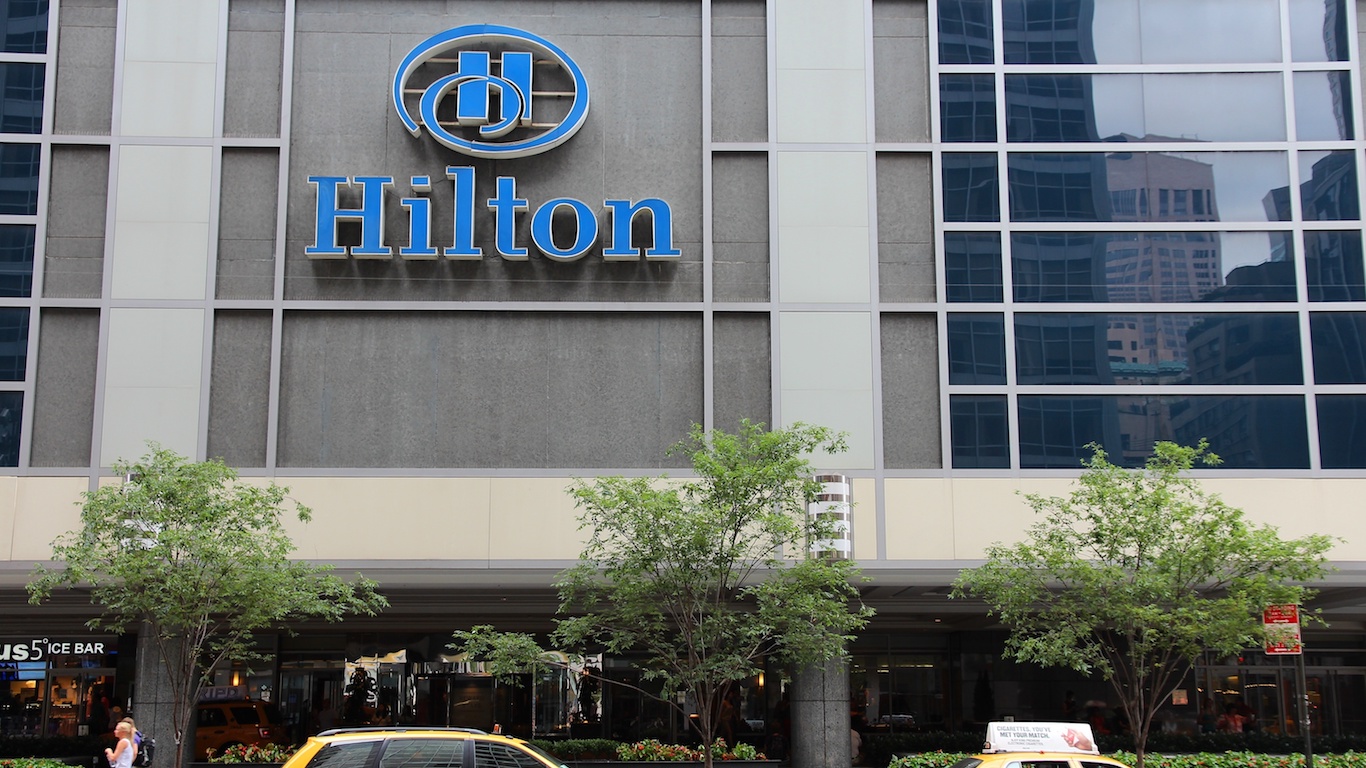
11. Hilton Worldwide Holdings Inc. (NYSE:HLT)
> Workforce: 169,000
> Annual profit: $364.0M
> CEO salary: $3.2M (Christopher J. Nassetta)
> Industry: Hotels and motels
Hilton Worldwide Holdings operates several hotel chain brands, including Embassy Suites, Hampton Inn, and Hilton Hotel and Resorts. The company is among the largest and lowest paying in the United States.
Two of the most commonly reviewed jobs on Glassdoor are front desk agent and guest service agent, positions that report an average hourly wage of $11.80 and $12.17, respectively. To compare, the national median hourly wage is $17.81. Meanwhile, hotel attendants, the most commonly reviewed salaried position, report an average annual salary of only $21,895 a year, which is only slightly higher than the poverty line for a family of three.
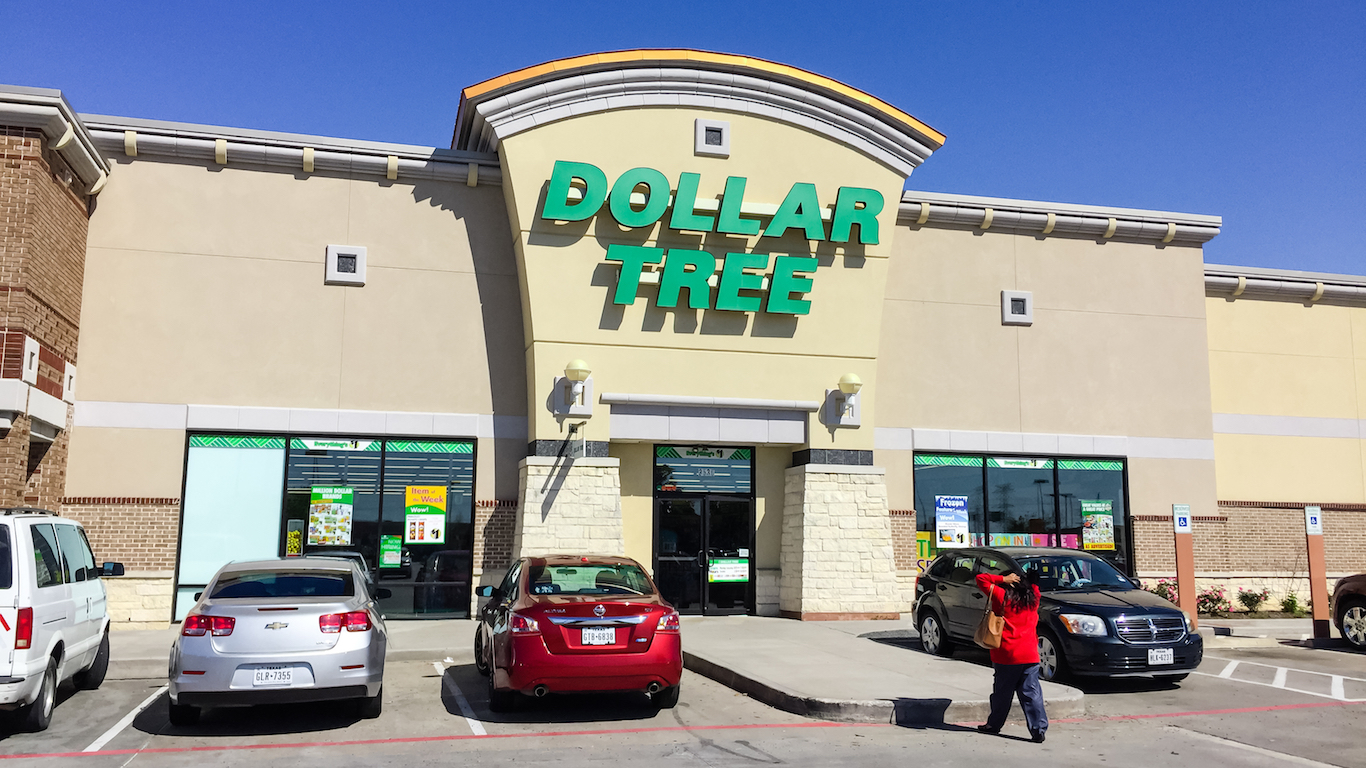
10. Dollar Tree, Inc. (Nasdaq:DLTR)> Workforce: 176,800
> Annual profit: $896.2M
> CEO salary: N/A (Gary Philbin)
> Industry: Variety stores
The Dollar Tree is one of several discount stores to make this list. The chain employs some 176,800 workers nationwide, both full- and part-time. Consumers likely appreciate the store for famously offering its products for $1 or less, but such low prices come at cost, including low wages for company workers. According to salary data reported on Glassdoor, Dollar Tree cashiers earn only $8.25 per hour, and sales associates earn only $8.26 an hour — far less than the national median hourly wage of $17.81. Low wages can go a long way in undermining employee morale, and less than half of all Dollar Tree employees who reviewed the company on Glassdoor would recommend a job with the company to a friend.
Dollar Tree acquired Family Dollar in 2015, roughly doubling the company’s total number of properties.
[in-text-ad]

9. Darden Restaurants, Inc. (NYSE:DRI)
> Workforce: 178,729
> Annual profit: $479.1M
> CEO salary: $2.9M (Eugene I. Lee)
> Industry: Eating places
Darden Restaurants, Inc. is the company behind several well known eateries, including Longhorn Steakhouse, The Capital Grille, and Olive Garden. All told, the company employs some 165,000 hourly workers in 1,689 U.S. restaurants and another six in Canada. Hourly service industry workers are often tipped by customers, and are paid very little by their employers. Servers employed by Darden make an average hourly wage of only $4.49 an hour.
Despite the low wages, Darden employees appear to be relatively satisfied. They tout the company’s benefits such as flexible scheduling options and restaurant discounts.

8. Marriott International, Inc. (Nasdaq:MAR)
> Workforce: 226,500
> Annual profit: $780.0M
> CEO salary: $4.2M (Arne M. Sorenson)
> Industry: Hotels and motels
The accommodations industry is one of the lowest paying in the country, and Marriott International ranks as one of two hotel chains with some of the lowest-paid employees. Labor unions are a practical way for workers to strengthen their bargaining power and ultimately negotiate higher wages. However, only about 10% of Marriott’s 226,500 employees are union members.
Employees at U.S. Marriott locations working the most common jobs, such as front desk agent, housekeeper, and guest service representative, earn below the poverty level set for a family of four.
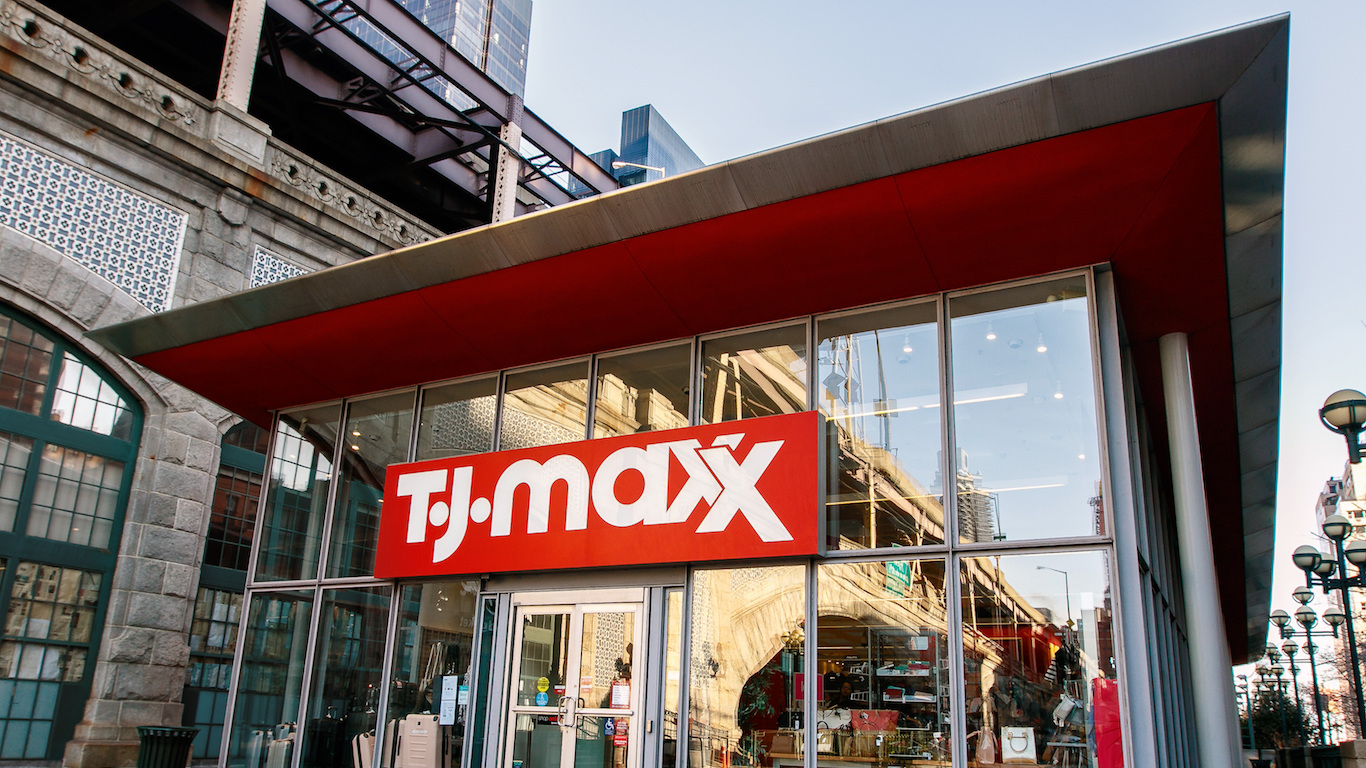
7. The TJX Companies, Inc. (NYSE:TJX)
> Workforce: 235,000
> Annual profit: $2.3B
> CEO salary: $8.1M (Ernie Herrman)
> Industry: Family clothing stores
The TJX Companies, Inc. owns and operates some 2,856 T.J. Maxx, Marshalls, and HomeGoods stores throughout the United States. TJX sells name brand merchandise at discounts ranging anywhere from 20% to 60% below their normal retail price. The company is able to sell at a discount while remaining profitable by implementing several strategies. The company buys it merchandise from cancelled orders, manufacturer overruns, and factory closeout sales. And it lowers overhead by cutting costs on store fixtures, advertising — and apparently, employee pay. The company is currently facing lawsuits brought on by current and former employees. The employees allege they were not paid fairly for overtime work and, in other cases, not paid all wages due upon their termination.
[in-text-ad-2]

6. Starbucks Corporation (Nasdaq:SBUX)
> Workforce: 254,000
> Annual profit: $2.8B
> CEO salary: N/A (Kevin Johnson)
> Industry: Eating places
Service industry jobs are among the lowest paying in the United States, and Starbucks is one of the largest service industry employers in the country. Nationwide, the company employs some 170,000 people. According to Glassdoor, the typical Starbucks barista makes less than $10 an hour.
As is almost always the case, low pay is not an issue for corporate leadership. Starting in October 2017, former Sam’s Club CEO Rosalind Brewer will take over as Starbucks’ chief operating officer. Brewer will enjoy a $1 million signing bonus in addition to $7 million equity bonus and a $1 million base salary. Including benefits, Starbucks’ new second in command will make over 430 times the amount of a barista working full time in her first year.

5. Aramark (NYSE:ARMK)
> Workforce: 266,500
> Annual profit: $288.2M
> CEO salary: $6.0M (Eric J. Foss)
> Industry: Eating places
Aramark is a Fortune 500 company headquartered in Philadelphia with operations in 19 countries and approximately 270,000 employees overall. The company, which recently became the official merchandise concessionaire of the National Football League, provides food, facilities, and uniform services to a range of clients in sports, education, healthcare, and business.
Food services is a relatively low paying industry, and the average salary for an Aramark food service worker is only $23,393 a year — about $1,000 below the federal poverty level for a family of four.
[in-text-ad]

4. Target Corporation (NYSE:TGT)
> Workforce: 323,000
> Annual profit: $2.7B
> CEO salary: $1.6M (Brian C. Cornell)
> Industry: Variety stores
Target employs some 323,000 Americans in 1,802 retail locations across every U.S. state with the exception of Vermont. Nationwide, the retail giant pays sales floor team members and cashiers an average hourly wage of $9.35 and $9.24, respectively.
Low employee pay may be necessary for Target to remain lean enough to survive. At a time when many major brick-and-mortar retailers are being gutted by e-commerce retailers, Target is bucking the trend. While department store chains like Sears and Macy’s are shuttering stores each year, Target plans on opening 30 in 2017, including a location in midtown Manhattan.
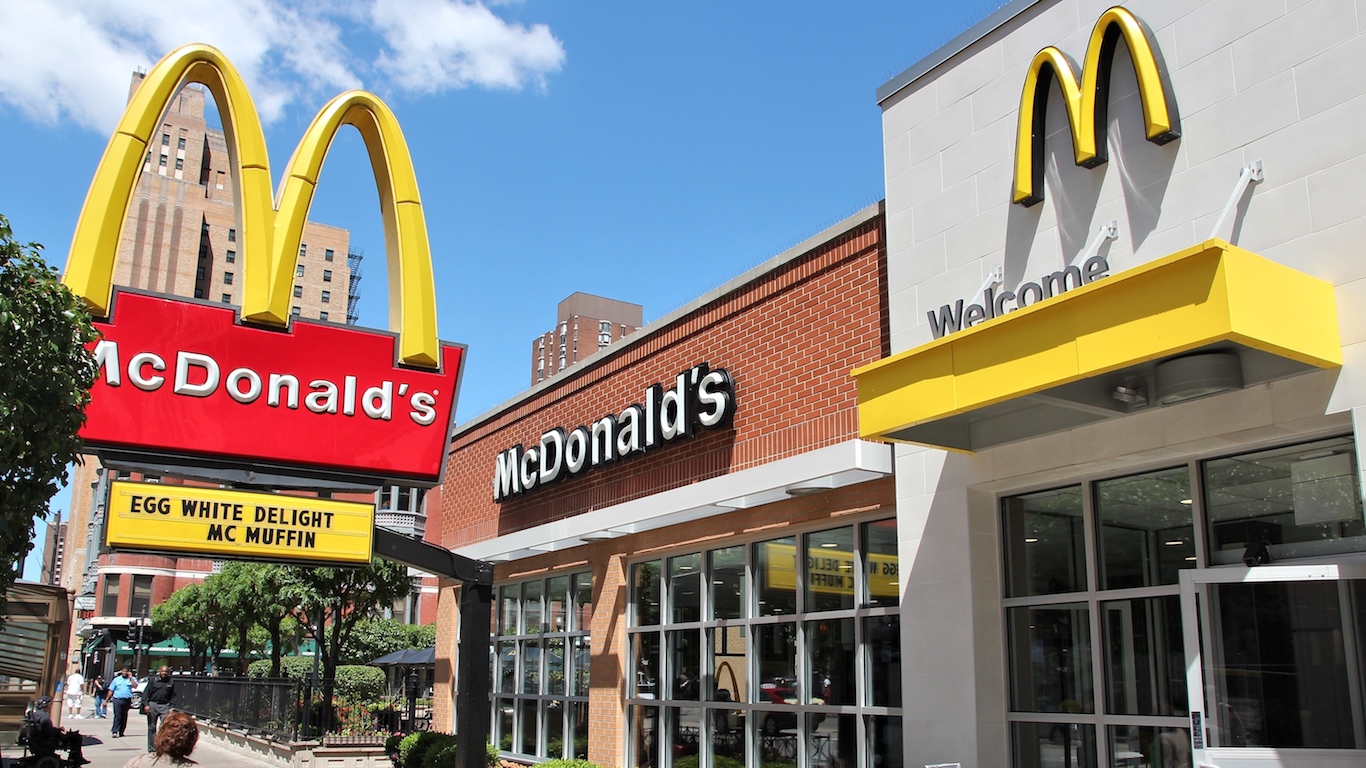
3. McDonald’s Corporation (NYSE:MCD)
> Workforce: 375,000
> Annual profit: $4.7B
> CEO salary: $6.4M (Stephen J. Easterbrook)
> Industry: Eating places
In 2015, McDonald’s made headlines for pledging to pay employees at least $1 more per hour than the legal minimum wage. While the move was a boon for the company’s public relations, about 90% of McDonald’s employees did not benefit from the raise as it only applied to company-owned stores and not franchised locations. Today, as one of the largest fast food chains by employment, the company ranks among those paying Americans the least. The company has some 14,155 restaurants across the United States and directly employs 375,000 people worldwide. In the U.S., the typical McDonald’s crew member earns only $8.43 an hour.

2. The Kroger Co. (NYSE:KR)
> Workforce: 443,000
> Annual profit: $2.0B
> CEO salary: $2.3M (W. Rodney McMullen)
> Industry: Grocery stores
Present in nearly every American town, grocery stores are among the biggest employers in the United States. They are also among the lowest paying. The median hourly wage among grocery stores in the United States is only $10.89 — well below the median wage in most other jobs paying by the hour. Wages for many employees at Kroger, one of the largest U.S. grocery chains by total employment, is even lower. Despite the fact that the majority of Kroger employees are covered by collective bargaining agreements, the average hourly wage for a Kroger cashier is only $8.39, according to hundreds of reviews on Glassdoor. Kroger employs some 443,000 workers across 2,796 U.S. locations.
[in-text-ad-2]
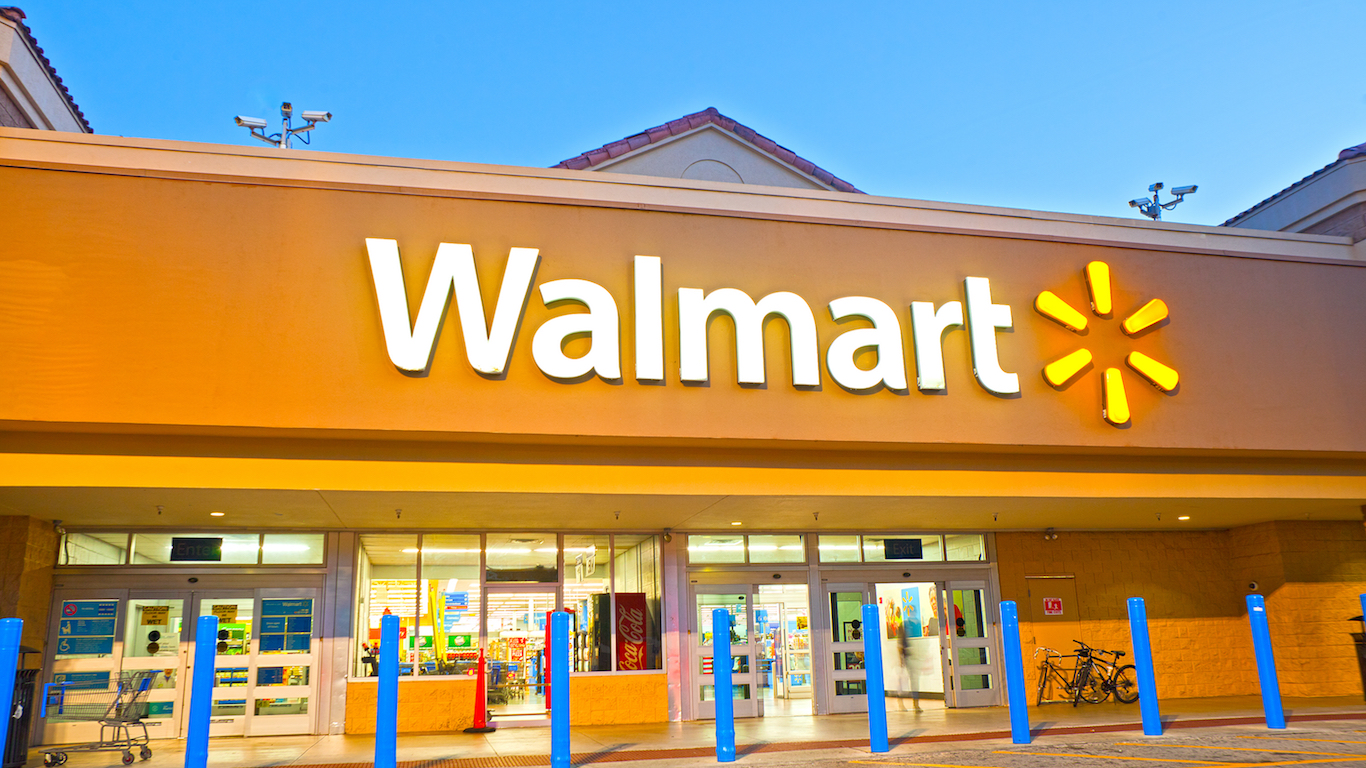
1. Wal-Mart Stores, Inc. (NYSE:WMT) (sam) done
> Workforce: 2.3M
> Annual profit: $14.3B
> CEO salary: $1.3M (C. Douglas McMillon)
> Industry: Variety stores
Wal-Mart Stores, Inc. is the parent company of Sam’s Club and Walmart — the world’s largest department store. Walmart is also the world’s largest company, with an annual revenue of $481.3 billion, and largest employer, with a total of 2.3 million workers. Cashiers earn an average hourly wage of only $9.36, and sales associates report average wages of only $9.41 per hour. To compare, the national median hourly wage is $17.81.
Wal-Mart’s strict anti-union stance and policies have helped it keep wages low for its massive workforce. The company is notorious for actively oppressing unionization, using store managers as a first line of defense against employees organizing.
Detailed Findings & Methodology
Feeling the squeeze from e-commerce retailers, many of the companies on this list are struggling with declining revenue as online shopping becomes increasingly popular. According to a recent report by consultancy group Deloitte, 2017 will be the first year more Americans will do their holiday shopping online rather than in brick-and-mortar stores.
More than a third of the 25 employers on this list are primarily department stores — and many reported falling revenues in the most recent fiscal year. Low employee wages may be a necessity for these companies as they lose market share to internet retail giants like Amazon.
Unions are one of the most common and effective ways for workers to negotiate higher wages. Not surprisingly, union membership tends to be low in the companies on this list. In some cases — including Walmart, the world’s largest employer — companies are anti-union and take active measures to keep employees from organizing.
The companies on this list also include discount stores such as Dollar General and Dollar Tree. Considering their low-cost inventory, these stores likely cannot remain profitable without paying employees relatively little.
Based on the methodology used by the National Employment Law Project, an employment advocacy organization, in its 2012 report “Big Business, Corporate Profits, and the Minimum Wage,” 24/7 Wall St. identified the 25 large companies that pay employees the lowest wages. These companies operate in industries that typically pay low wages.
We first identified the three sectors that have the highest percentages of workers that are paid at or below the minimum wage from the BLS’ Occupational Employment Statistics database and its report, “Characteristics of Minimum Wage Workers, 2016.” The three sectors — leisure and hospitality, retail trade, and education and health services — together employ 78.4% of all workers paid the minimum wage or less.
Within these sectors, we then identified the 31 industries in which the median wage was at most $13 an hour — $5.75 above the federal minimum wage.
We identified the 147 lowest-paying public U.S. companies within those 31 industries by using the Capital IQ Screening tool, accessed September 2017. The 25 lowest paying companies are the largest employers among the 147 low-paying companies. Worldwide totals, full-time and part-time employee counts, as well as annual profit figures from the latest three fiscal years came from various corporate filings with the Securities and Exchange Commission. Company information also came from corporate websites and financial documents submitted to the SEC. CEO salaries came from Yahoo Finance.
We reviewed salary information submitted by employees to employee review site Glassdoor in order to screen any companies where wages for the most common occupations were not close to or less than $13 an hour. To calculate average wages and salaries, Glassdoor uses data from current and former employees, in addition to third party sources, emphasizing more recent salaries from within the last two years. Salary and wage estimates do not include bonuses, commissions, tips, stock options, and other benefits.
In keeping with the NELP methodology, all employee figures represent system-wide employment, including employees of franchisees, unless otherwise noted. Employee totals also include both full- and part-time workers and represent worldwide employment, unless otherwise noted.
Choosing the right (or wrong) time to claim Social Security can dramatically change your retirement. So, before making one of the biggest decisions of your financial life, it’s a smart idea to get an extra set of eyes on your complete financial situation.
A financial advisor can help you decide the right Social Security option for you and your family. Finding a qualified financial advisor doesn’t have to be hard. SmartAsset’s free tool matches you with up to three financial advisors who serve your area, and you can interview your advisor matches at no cost to decide which one is right for you.
Click here to match with up to 3 financial pros who would be excited to help you optimize your Social Security outcomes.
Have questions about retirement or personal finance? Email us at [email protected]!
By emailing your questions to 24/7 Wall St., you agree to have them published anonymously on a673b.bigscoots-temp.com.
By submitting your story, you understand and agree that we may use your story, or versions of it, in all media and platforms, including via third parties.
Thank you for reading! Have some feedback for us?
Contact the 24/7 Wall St. editorial team.